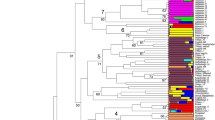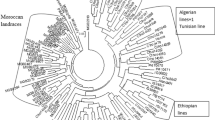Abstract
The variation in length of the intergenic spacer (IGS) region of the ribosomal DNA repeat unit was examined in 63 accessions of wild barley, Hordeum spontaneum, and seven accessions of cultivated barley, Hordeum vulgare. The accessions of wild barley were collected from ecologically diverse climatic and edaphic microsites in Israel, and the barley cultivars were those grown in India. Sixteen spacer-length variants (slvs) observed in the present study presumably belonged to two known rDNA loci (Rrn1 and Rrn2). Each accession had one or more variants, which together represented the rDNA phenotype. The rDNA phenotypes of wild barley accessions were widely diverse and differed substantially from those of cultivated barley. The slv phenotypes and the corresponding alleles were shown to be largely correlated with different climatic, edaphic and ecogeographical microsites and niches (the ”Evolution Canyon” at Lower Nahal Oren, Mount Carmel; and Tabigha, Eastern Upper Galilee Mountains), so that a particular rDNA phenotype of an accession could be used to predict the climate and soil to which the accession belonged. This sharp microsite ecogeographic variation in ribosomal DNA appears adaptive in nature, and is presumably driven by climatic and edaphic natural selection.
Similar content being viewed by others
Author information
Authors and Affiliations
Additional information
Received: 1 March 2001 / Accepted: 21 May 2001
Rights and permissions
About this article
Cite this article
Gupta, P., Sharma, P., Balyan, H. et al. Polymorphism at rDNA loci in barley and its relation with climatic variables. Theor Appl Genet 104, 473–481 (2002). https://doi.org/10.1007/s001220100690
Issue Date:
DOI: https://doi.org/10.1007/s001220100690




